Surya › Magadha Kingdom » Ancient origins
Articles and Definitions › Contents
- Surya › Ancient History
- Magadha Kingdom › Antique Origins
Ancient civilizations › Historical and archaeological sites
Surya › Ancient History
Definition and Origins
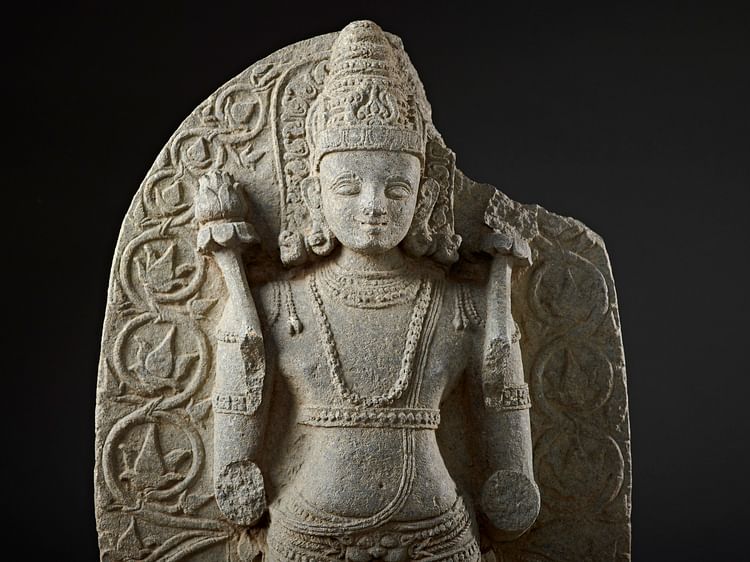
Surya (also known as Aditya) is the Hindu god of the Sun. He is considered the creator of the universe and the source of all life. He is the supreme soul who brings light and warmth to the world. Each day he travels across the sky in his golden chariotpulled by seven horses and driven by red Aruna, a personification of Dawn. The god's most famous temple is at Konarak in Orissa, north-east India but he was worshipped across the Indian subcontinent. Still an important figure in Hinduism today, he is also a minor deity in Buddhism.
ASSOCIATIONS & MYTHOLOGY
Surya is known by many alternative names and epithets which include Vivasvat (Brilliant), Savitr (the Nourisher), Bhaskara (Light-maker), Dinakara (Day-maker), Lokacaksuh (Eye of the World), Graharaja (King of the Constellations), and Sahasra-kirana (Of a 1,000 rays). Vishnu, who later largely replaces Surya's function in the Hindu pantheon, is referred to as Surya-Narayana in his incarnation as the sun.
Surya first appears in literature in the Rigveda, oldest of the Vedas sacred texts and composed between 1500 and 1000 BCE. The bringer of the Sun, Surya was thought to ride his chariot across the sky and defeat the demons of darkness. He is represented as such in a doorway relief at the 2nd-century BCE Buddhist cave temples and monk cells of Bhaja, Shunga in western India.
THE BRINGER OF THE SUN, SURYA WAS THOUGHT TO RIDE HIS CHARIOT ACROSS THE SKY & DEFEAT THE DEMONS OF DARKNESS.
According to some myths Surya is the son of Kasyapa (a Vedic sage) and Aditi (Infinite Heavens), in others he is the offspring of Dyaus (Sky), and in still others his father is Brahma. Surya had three offspring with Samjna (Conscience), the daughter of Visvakarma. These were Vaivasvata (one of the 14 original men or Manu), Yama (god of the dead), and Yami (goddess of the Yamuna river). Unfortunately, Samjna became so tired of Surya's brilliant light that she one day gave him a handmaid, Chaya (Shade), and left him to live a life of reflection in the forests, transformed into a mare. Surya was not to be so easily deprived though and disguised as a stallion mated with Samjna. The resulting offspring were Revanta (chief of the Guhyakas) and two twin sons, the youthful Ashvins, who travel before his chariot in their own golden version or on horseback.
Meanwhile, Visvakarma chipped off some of Surya's brilliance, perhaps to try and dim the god and make him a little easier for his daughter to live with. From these blazing fragments were made various weapons of the gods, including Vishnu's discus, Shiva ’s trident, Kubera's club, and Karttikeya's lance.
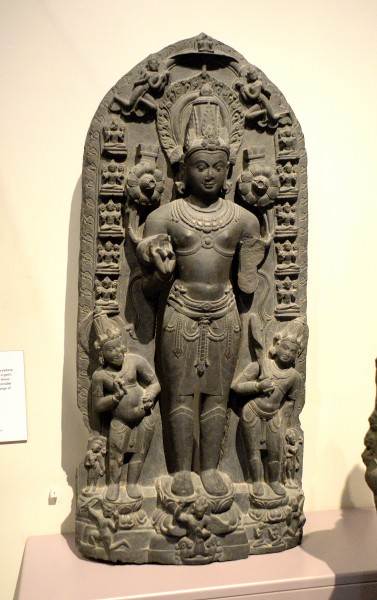
Surya
Various other offspring sometimes attributed to Surya include the monkey chief Sugriva, Ushas, the personification of Dawn in early texts, and Sani, the personification of the planet Saturn. Surya is considered the chief of the nine planets of Vedic antiquity. These are the Sun, Moon, Mercury, Mars, Venus, Jupiter, and Saturn, plus the solar and lunar shadows (ascending and descending nodes) of Rahu and Ketu, all visible to the naked eye. Collectively they are known as the Navagraha.
In other stories involving Surya, the sun-god gave the White Yajurveda (a collection of mantras) to the sage Yajnavalkya. Ever generous, Surya also gave the magical syamantaka gem to Satrajit, a nobleman known for his devout worship of the god. This stone, if the owner were a good person, could produce a huge quantity of gold on a daily basis and dispelled all fears. If the owner was evil, then it proved their undoing with deadly consequences.
WORSHIP
Surya and the Adityas, the collective name for the solar deities, were especially popular in the Vedic period, the sun-god being considered at that time one of the three most important gods. Later, Surya was replaced in importance by such deities as Shiva and Vishnu. Still, to some he remains an important god in both India and Nepal. He is celebrated during the harvest festival of Pongal in southern India and by Tamils in general. Smarta followers also consider him one of their most important gods. Followers of the god are known as Sauryas. Surya appears in the important Gayatri mantra which is recited from the Vedas as a preliminary to its study. Finally, in Buddhism Surya is considered to dwell in and protect shrines.

Temple of Surya, Konarak
TEMPLES TO SURYA
The god had many temples and shrines across ancient India but certainly the most celebrated temple built in honour of Surya is in the Orissa region at Konarak. Constructed in the 13th century CE using sandstone, it has 12 pairs of huge stone wheels incorporated into the sides of the building to represent the months of the year and give the impression the whole temple is the chariot of Surya. The effect is further enhanced by seven horses sculpted at its front and standing either side of the staircase.The cult of Surya was founded at the site by Narasimha I (r. 1238-1264 CE). Statues of the sun-god adorn niches on the temple exterior. One example panel shows Surya wearing a conical crown and standing above his seven chariot horses. He is bedecked in jewels and accompanied by a smaller figure of Aruna.
Another famous temple dedicated to the god is at Martand in the Srinagar valley of Kashmir. It was built in the second half of the 8th century CE by the Karkota king Lalitaditya Muktapida. The limestone temple is an interesting example of the influence of Classical architecture in the region and has fluted columns and Corinthian-like capitals in the rectangular colonnade which measures 67 x 42 metres and surrounds the temple proper. Today the temple is a mere ruin of its former self, but it remains the earliest Hindu monument in Kashmir.
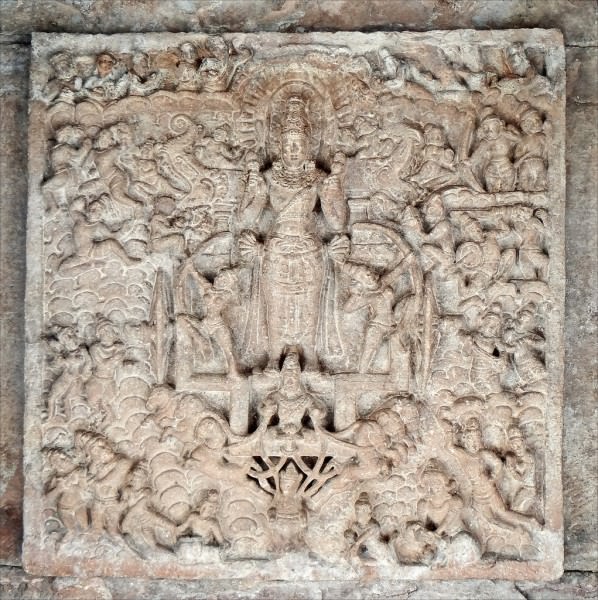
Relief Sculpture of Surya in Virupaksha Temple, Pattadakal
SURYA IN HINDU ART
Surya appears both in figure sculpture and on temples across India. He is often portrayed wearing tall boots and a flowing tunic which represent his coming from another world (Parthian or Kushan?). This unusual iconography continues right up to the 12th century CE across India; an outstanding example is the bronze figure from Kashmir now in the Cleveland Museum of Art. Surya may ride his chariot led by seven horses or a single horse with seven heads (representing the colours of the rainbow and seven chakras), all with rays of light shining from them. Unlike many other Hindu gods Surya is usually depicted with only two arms and not the typical four. In the Cham art of ancient Vietnam and Cambodia, Surya is often portrayed riding a horse and wielding a huge sword, no doubt, in reference to his daily slaying of the demons of darkness.
Depictions of the god on Ossian temples show Surya holding lotuses in each hand and wearing a jewelled crown and loincloth.The outstanding examples of this type are the green chlorite panel dominated by the life-size figure of Surya from his temple at Konarak, now in the National Museum, New Delhi and the polished slate panel from Ganga Sagar, now in the Philadelphia Museum of Art.
Magadha Kingdom › Antique Origins
Definition and Origins
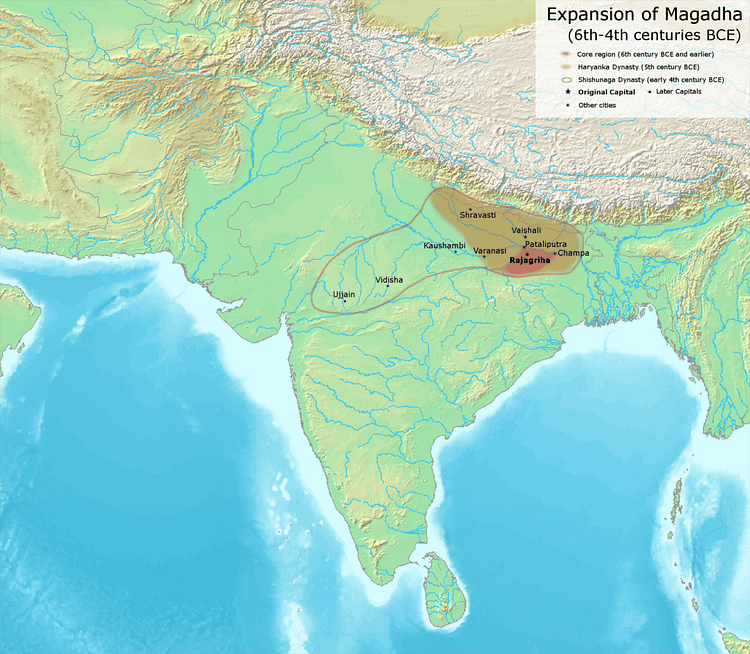
Magadha was an ancient kingdom located on the Indo-Gangetic plains in eastern India and spread over what is today the modern state of Bihar. At the height of its power, it claimed suzerainty over the entire eastern part of the country (roughly the area of England ) and ruled from its capital at Pataliputra (modern Patna, Bihar). In 326 BCE, when Alexander the Great was camped at the river Beas on the westernmost part on India, his army mutinied; they refused to march further east. They had heard about the great Magadha kingdom and were unnerved by stories of its might. Unwillingly, Alexander turned back (and was to die en route ). But this was not the first time that the might of Magadha had forced kings westwards. One of the earliest references to Magadha is in the epic Mahabharata, where we see the entire Yadava clan abandoning their homeland on the Gangetic plains to migrate south-westwards towards the desert-ocean land to avoid constant battles with their eastern neighbour, Magadha.
ANCIENT MAGADHA, & JARASANDHA
The Magadha kingdom did not seem to have been liked by the vedic people. In the Atharva Veda, a charm against virulent fever speaks somewhat sarcastically of banishing the fever to the people of Magadha, inter alia.
गंधारिभ्यो मूजवद्भ्यो अड़ेभ्यो मगधेभ्यः ॥ प्रैष्यन्जनमिव शेवधि तक्मानं परि दध्मसि ॥
Over to the Gandharis, the Magavants, the Angas, and the Magadhas, do we deliver the fever, like a servant, like a treasure. [Atharva Veda, V.22.14]
THE CAPITAL OF MAGADHA WAS GIRIVRAJ WHICH WAS SORROUNDED BY RINGS OF MOUNTAINS & WAS, THEREFORE, DIFFICULT TO LAY SIEGE TO.
In the Mahabharata, Magadha is the mightiest kingdom in the country, stronger even than the Kurus (of whom the epic is all about). Magadha controlled the entire eastern part of the country through alliances with smaller vassal states. It was constantly at war with its western neighbours, the Yadavas of Mathura, who ultimately migrated far west to the sea coast near the Rann of Kutchh (modern Gujarat) because they could no longer afford the resources needed to protect their kingdom from the regular onslaughts of the Magadha king, Jarasandha. This flight meant that Magadha's borders extended right upto the Kuru-Panchal kingdoms, where lived the Pandavas and the Kauravas. Jarasandha had powerful allies around his main kingdom: to the southwest was the vassal state of Chedi (to the south of which was another ally, Vidarbh), to the east were the allies of Anga and Vanga, and further east was the friendly country of Pragjyotishpur (modern Assam), ruled by a demon whose borders extended right up to China. This entire stretch of land looked to Jarasandh as their overlord.
The capital of Magadha was Girivraj (modern Rajgir, Bihar). This city was sorrounded by rings of mountains and was, therefore, difficult to lay siege to. Jarasandh had imprisoned 99 minor kings, and had intended to offer a big human sacrifice after the 100th king was captured but before he could do so, he was defeated in a wrestling match by the Pandava Bheem, and ripped apart into two. Jarasandh's son was placed on the throne but was later to die fighting for the Pandavas in the Kurukshetra war.
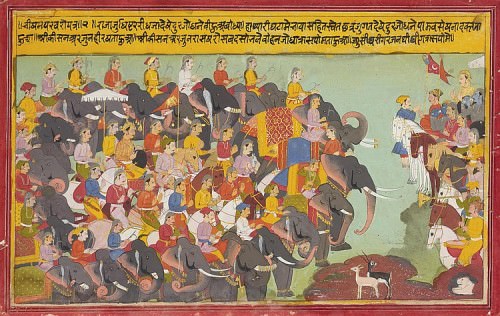
The Kurukshetra War
After the Kurukshetra war, the power of Magadha seems to have diminished somewhat because there are references to it being annexed by a south-western neighbour, Avanti. It continued to be an important kingdom, however, and was counted among the 16 principal states of ancient India.
MAGADHA AT THE TIME OF THE BUDDHA
At around the time that Gautama Siddhartha became the Buddha, Magadha was a flourishing kingdom under its king Bimbisara. Under Bimbisara, Magadha annexed the neighbouring eastern kingdoms, and made marriage aliances with the ones in the west and north. He was friends with another neighbour, Avanti, to whose king he sent his own physician when the Avanti king was ill. The country was ruled by the king with help from three classes of officials: the executive, the judiciary, and the military. It was during Bimbisara's rule that Gautama Siddhartha, the heir-prince of a country north of Magadha, came there wandering, seeking the eternal truth, and attained enlightenment at Bodh Gaya to become the Buddha.
GAUTAM SIDDHARTH, CROWN PRINCE OF A COUNTRY NORTH OF MAGADHA, WANDERED ALL OVER MAGADHA AND VATSA, SEEKING THE ETERNAL TRUTH. IT WAS FINALLY AT BODH GAYA IN MAGADHA THAT HE ATTAINED ENLIGHTENMENT TO BECOME THE BUDDHA.
Bimbisara was succeeded by his son Ajatashatru, who shifted the capital of Magadha from Girivraj to Pataliputra (modern Patna, Bihar). Ever since, Pataliputra has remained the capital of that province, down to this day. Ajatashatru also expanded his father's territories considerably; he annexed Kosala, the Lichchhavi republic, Kashi, and Avanti. Some of these kingdoms were related to him by blood but Ajatashatru is generally depicted as a cruel person not given to family niceties (he had deposed and imprisoned his father to ascend the throne). The battle with the Lichchhavi republic was a long-drawn out affair, and we have descriptions of some of the military innovations that Ajatashatru implemented: one was a catapult that could throw heavy stones a great distance ( mahashilakantaka ), and another was a self-propelling, covered chariot that had rotating spears and blades attached to its wheels ( rathamushal ). An interesting fallout of the Magadha-Lichchhavi war was the affair of Ajatashatru with the Lichchavi state courtesan Amrapali. The destruction of the Lichchhavi lands by Magadha so pained Amrapali that she became a Buddhist nun; her son by Ajatashatru went on to become a Buddhist monk.
Ajatashatru was against the Buddha to begin with but became a friend later. When the Buddha died and his remains were distributed among his disciples, a major share fell to Ajatashatru who was the most powerful king of that period. He enshrined the relics inside a stupa at Girivraj. Later, he hosted the first ever council of Buddhist monks, when about 500 of them congregated at the Magadha capital for the Great Council.

Remains of Ajatashatru's stupa
There are conflicting reports about the successors of Ajatashatru but about 50 years after his death, the people of Magadha deposed the hereditory king and elected a minister named Shishunag to the throne. Shishunaga was succeeded by his son, during whose reign the Second Buddhist Council was held in Magadha. This king was killed in a palace conspiracy and was succeeded by Mahapadma Nanda.
THE NANDAS
The origins of the Nandas is obscure; however, all of the texts of that period agree that Mahapadma Nanda, the kingslayer, was of low birth and a paramour to one of the queens. He reconquered all of the lands that Magadha had lost under Ajatashatru's successors, and extended the kingdom to right inside the Deccan plateau of India. By the time that Alexander had invaded the western frontiers of India, the Nanda dyansty had expanded Magadha to the Gangetic seacoast in the east and to the Punjab in the west. Thus, if Alexander were to march any further east, he would have had have to reckon with a mighty kingdom having the full resources of the entire northern India under its control; Magadha's army consisted of 20,000 cavalry, 200,000 infantry, 2,000 chariots, and 3,000 elephants. Alexander's army mutinied; they refused to fight an army that formidable.

Alexander the Great, Ptolemaic Coin of Alexandria
THE FALL OF MAGADHA
Despite the extreme wealth and the military might of Magadha, its king was hugely unpopular on account of his cruelty and the high rates of taxation he imposed on the populace. The Buddhist texts of the period say that the king was given to digging up the riverbed of the Ganges and burying his gold there. So enduring were stories of the fabulous wealth of the Nandas that Hieun Tsang, the Chinese pilgrim touring the country in the 7th century CE, almost 600 years later, makes a reference to it.
After Alexander left for Greece, the departure created a power vaccuum in western India. Chandragupta Maurya stepped into this vaccuum, subjugated these kingdoms, and then entered Pataliputra and killed the Nanda king. The details of this overthrow are unclear but it is assumed that Chandragupta Maurya had the support of the populace and the palace. The mighty Magadha kingdom had given way to a kingdom even more powerful: the Mauryan Empire.
See other Related Contents ››
LICENSE:
Article based on information obtained from these sources:with permission from the Website Ancient History Encyclopedia
Content is available under License Creative Commons: Attribution-NonCommercial-ShareAlike 3.0 Unported. CC-BY-NC-SA License